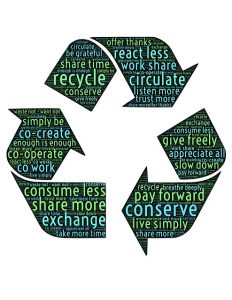The impacts of human activity on the environment are myriad: global warming, environmental degradation, biodiversity loss, overexploitation, pollution, etc. As the global population continues to expand and the overriding patterns of production, consumption and trade remain severely unsustainable, a global rethink of the current model of growth is required. Cities, as home to more than half of the world’s population and central engines of the global economy, have the potential to play a critical role in this transformation.
Challenges for Sustainability
 Sustainability is defined as meeting the needs of the current generation without compromising the ability of future generations to meet their own needs. However, the current production-consumption structure is challenging the Earth’s natural systems and jeopardizing the health and welfare of future populations.
Sustainability is defined as meeting the needs of the current generation without compromising the ability of future generations to meet their own needs. However, the current production-consumption structure is challenging the Earth’s natural systems and jeopardizing the health and welfare of future populations.
Rising consumption and resources constraints. The intensification of industrialization and growing middle class populations are increasing consumption demand. As the contemporary manufacturing and production models are largely based on resource extraction and material use, the annual material extraction worldwide has multiplied three-fold in the last decades, from 22 billion tons in 1970 to around 70 billion tons in 2010. In a business-as-usual scenario, it is expected to increase to 180 billion tons of materials by 2050 (which is equivalent to 30 billion adult male African elephants!). This massive extraction of natural resources is putting a severe strain on the natural environment.
Environmental impacts and waste generation. The current model of economic growth and consumption patterns result in huge negative environmental impacts, such as massive levels of land, water, air and noise pollution; greenhouse gas (GHG) emissions; and increasing waste generation. Only in cities, the global Municipal Solid Waste (MSW) generation levels are approximately 1.3 billion tons per year, and are expected to increase to some 2.2 billion tons per year by 2025. This not only increases waste management and collection costs, but also increases the negative environmental externalities on our planet.
Urbanization. The current wave of rapid and unplanned urbanization is intensifying some of the most negative environmental effects of urban life. Urban areas cover less than 2% of the Earth’s surface, but account for 75% of natural resources consumption, 50% of global waste production, and around 60-80% of GHG emissions.

The Circular Economy
If we want to achieve a more economically and environmentally sustainable growth, there is a need to change the current model of production and consumption in our economy. In this regard, the notion of a “Circular Economy” was born in the 1970s with the aim to provide a more sustainable growth model.
 The circular economy (CE) aims at changing the current open, linear “take-make-dispose” production-consumption model and adopt a new growth strategy in which the resource loop will be “closed”, by keeping the resources circulating at their highest value and utility, “decoupling” growth from material extraction, and minimizing waste generation. The final objective is to increase the efficiency of our natural systems, while reducing environmental impacts.
The circular economy (CE) aims at changing the current open, linear “take-make-dispose” production-consumption model and adopt a new growth strategy in which the resource loop will be “closed”, by keeping the resources circulating at their highest value and utility, “decoupling” growth from material extraction, and minimizing waste generation. The final objective is to increase the efficiency of our natural systems, while reducing environmental impacts.
The Ellen MacArthur Foundation, one of the leading voices of the circular economy, defines three key principles: (1) Design out waste and pollution; (2) Keep products and materials in use; and (3) Regenerate natural systems. Overall, the circular economy is a new economic model, but it is also a change of mindset.
The Role of Cities
Urban areas generate around 80% of global Gross Domestic Product (GDP) and are hubs of innovation, creativity and growth. As the number of people living in urban areas increases, cities have the potential to become key players in the transition towards more circular economies.
As centers of people, economy, talent, material resources and data, urban areas offer huge opportunities for new business models to emerge and new consumption patterns to develop. From waste collection and management, to new recycling practices, energy conservation, product design, the sharing economy, reverse logistics, among many others; urban areas are in a unique position to offer new approaches and innovative solutions to achieve sustainable prosperity.
Moreover, local governments are often more agile and flexible than national governments when it comes to implementing new policies and programs. From recycling and waste management policies, to setting specific targets on emissions or pollution levels, urban managers and local policymakers have the potential to influence the city’s environmental performance to a great extent. The type of initiatives and policies that city governments implement and execute will be decisive for the sustainability of our planet and the wellbeing of future generations. Local governments are also in charge of planning and designing cities. As urbanization accelerates, growing infrastructures and built urban environment will be needed. The way that urban managers design a city’s built environment, its land area and land use will affect the city’s ecological footprint.
The Circular City
Urban areas are usually thought as linear systems that receive inputs (water, materials, energy, people, food, etc.) and produce outputs (waste, emissions, pollution, etc.). However, cities could be designed as more sustainable/circular systems that use renewable energy, recycle/reuse most of its inputs, and reduce the outputs to the minimum.
The Ellen MacArthur Foundation defines a “Circular city” as a “city embeds the principles of a circular economy across all its functions, establishing an urban system that is regenerative, accessible and abundant by design.” This includes energy systems that are resilient and renewable; urban mobility systems that are accessible, affordable and sustainable; and production systems that encourage “local value loops”.
The city as a linear system VS the city as a circular system

The Way Ahead
The final aim of the circular economy is to be able to align economic, social and environmental objectives. If we want to achieve a more economically and environmentally sustainable growth, and make our cities more resilient, there is a need to change the current model of production and consumption in our economy, decoupling rising prosperity from resource extraction, improving resource efficiencies and developing cleaner energy sources and production processes. A change that must not only be technological, but also cultural and of consumption and production patterns. Do you think the circular economy could be the way forward towards more sustainable growth in cities? Let us know your thoughts in the comments section!
Our following post will continue to build on the concept of the circular economy and, more precisely, on how it can be applied and unfold in the urban context. It will look at some of the solutions and opportunities that have emerged in the past few years within the circular economy. Stay tuned for more information!





I guess the most important factors to be addressed are changing lifestyle (Toward a more nature-friendly living) and promoting urban agriculture to reduce the adverse effects of unsustainable transportation. We should learn to consume local products.
thanx . that was good article
I guess the most important factors to be addressed are changing lifestyle.
nice share thank you
I guess the most important factors to be addressed are changing lifestyle
most important factors to be addressed are changing lifestyle (Toward a more nature-friendly living) and promoting urban agriculture to reduce the adverse effects of unsustainable transportation
We appreciated. Thanks for the information
I think air pollution is the most important problem that will affect many cities in the future.
Thank you for the useful content of your site